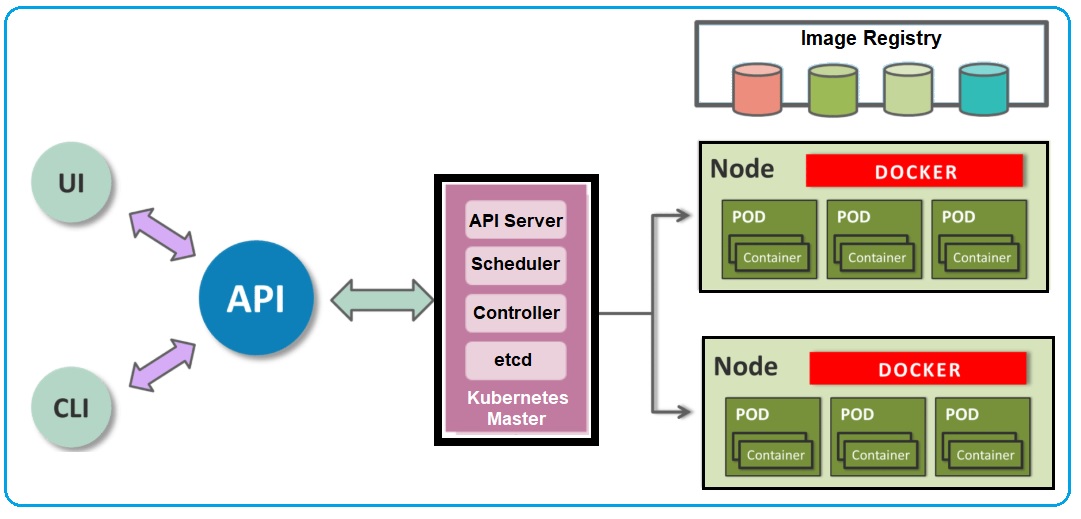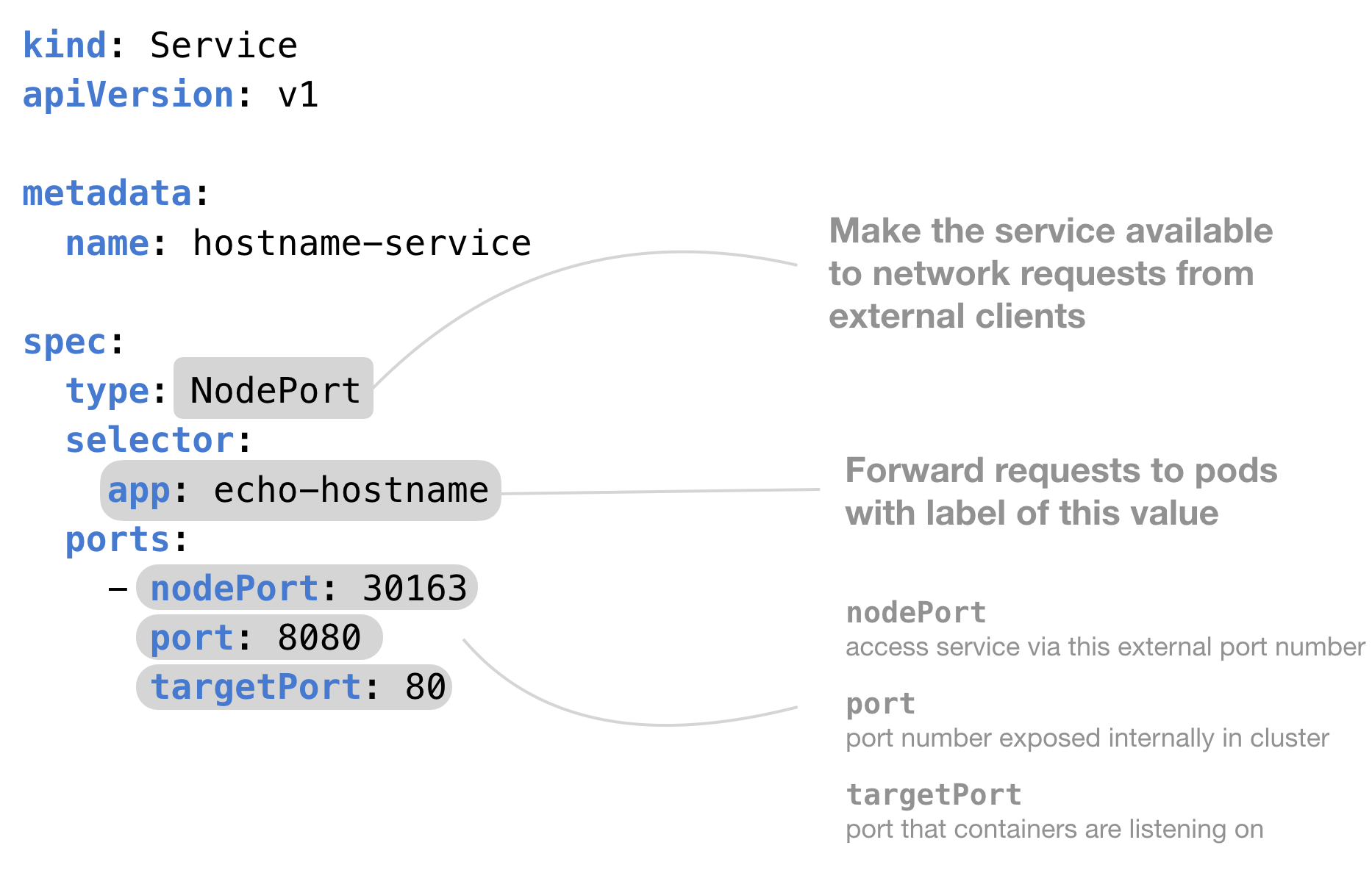Kubernetes and Docker - dennisholee/notes GitHub Wiki
Src: https://dzone.com/articles/docker-containers-and-kubernetes-an-architectural
Src: https://vocon-it.com/2018/12/03/how-to-create-a-kubernetes-cluster-with-kubeadm-kubernetes-series-3/
- Install Docker https://docs.docker.com/install/linux/docker-ce/ubuntu/
- Install Kubernetes Admin
kubeadmhttps://kubernetes.io/docs/setup/production-environment/tools/kubeadm/install-kubeadm/ - Setup cluster https://kubernetes.io/docs/setup/production-environment/tools/kubeadm/create-cluster-kubeadm/
Copy the below script to docker-install.sh and run from sudo
#!/usr/bin/bash
# Remove files
yum remove docker docker-common docker-selinux docker-engine-selinux docker-engine docker-ce
# Install prerequisite packages
yum install -y yum-utils device-mapper-persistent-data lvm2 http://mirror.centos.org/centos/7/extras/x86_64/Packages/container-selinux-2.95-2.el7_6.noarch.rpm
# Add docker community edition repo
yum-config-manager --add-repo https://download.docker.com/linux/centos/docker-ce.repo
# Install docker community edition package
yum install docker-ce
# Enable docker service
systemctl enable docker.service
# To execute:
# chmod u+x docker-install.sh
# sudo ./docker-install.shInstall kubernetes
Src: https://kubernetes.io/docs/setup/production-environment/tools/kubeadm/install-kubeadm/
cat <<EOF > /etc/yum.repos.d/kubernetes.repo
[kubernetes]
name=Kubernetes
baseurl=https://packages.cloud.google.com/yum/repos/kubernetes-el7-x86_64
enabled=1
gpgcheck=1
repo_gpgcheck=1
gpgkey=https://packages.cloud.google.com/yum/doc/yum-key.gpg https://packages.cloud.google.com/yum/doc/rpm-package-key.gpg
EOF
# Set SELinux in permissive mode (effectively disabling it)
setenforce 0
sed -i 's/^SELINUX=enforcing$/SELINUX=permissive/' /etc/selinux/config
yum install -y kubelet kubeadm kubectl --disableexcludes=kubernetes
systemctl enable --now kubelet
Install kubeadm kubectl and kubelet
cat <<EOF > /etc/yum.repos.d/kubernetes.repo
[kubernetes]
name=Kubernetes
baseurl=https://packages.cloud.google.com/yum/repos/kubernetes-el7-x86_64
enabled=1
gpgcheck=1
repo_gpgcheck=1
gpgkey=https://packages.cloud.google.com/yum/doc/yum-key.gpg https://packages.cloud.google.com/yum/doc/rpm-package-key.gpg
EOF
# Set SELinux in permissive mode (effectively disabling it)
setenforce 0
sed -i 's/^SELINUX=enforcing$/SELINUX=permissive/' /etc/selinux/config
yum install -y kubelet kubeadm kubectl --disableexcludes=kubernetes
systemctl enable --now kubelet
Src: https://www.cyberciti.biz/faq/install-use-setup-docker-on-rhel7-centos7-linux/
Note: Install selinux-container to resolve this error:
Error: Package: containerd.io-1.2.6-3.3.el7.x86_64 (docker-ce-stable)
Requires: container-selinux >= 2:2.74
Error: Package: 3:docker-ce-18.09.7-3.el7.x86_64 (docker-ce-stable)
Requires: container-selinux >= 2.9
- Containers uses two features of the Linux kernel:
- namespaces
- cgroups
Src: http://www.abusedbits.com/2016/09/docker-host-networking-modes.html
List docker network docker network ls
Inspect docker network docker network inspect {NETWORK}
Build Docker Image
docker build -t .
Build Docker Image and publish to Google Container Registry
gcloud auth configure-docker
docker build -t gcr.io/{project}/{image_name} .
docker push asia.gcr.io/{project}/{image_name}
List Docker images
docker images
Publish Docker image
docker push
Docker containers
# Get the container name
docker container ls
# Builds a new image from the source code.
docker build -t {REPOSITORY}:{TAG} .
# Creates a writeable container from the image and prepares it for running.
Docker create
# Creates the container (same as docker create) and runs it.
docker run -d -p {HOST_PORT}:{CONTAINER_PORT} -v {HOST_PATH}:{CONTAINER_PATH} --net {NETWORK} {IMAGE}
# Start container
docker container start <container name>
# Open bash
docker exec -it <container name> /bin/bash
- The applications in a Pod all use the same network namespace (same IP and port space), and can thus “find” each other and communicate using localhost.
- Applications in a Pod must coordinate their usage of ports.
- Each Pod has an IP address in a flat shared networking space that has full communication with other physical computers and Pods across the network.
Multiple pods running across multiple nodes of the cluster can be exposed as a service. This is an essential building block of microservices. The service manifest has the right labels and selectors to identify and group multiple pods that act as a microservice.
Src: https://matthewpalmer.net/kubernetes-app-developer/articles/service-kubernetes-example-tutorial.html
kubectl get namespaces
kubectl create ns {Namespace name}
apiVersion: vl
kind: Pod
metadata:
name: my-ns-pod
namespace: my-ns
labels:
app: myapp
spec :
containers:
name: myapp-container
image: busybox
command: I ' sh ' . ' -c ' , ' echo Hello Kubernetes!
Services in Kubernetes expose their endpoint using a common DNS pattern. It looks like this:
<Service Name>.<Namespace Name>.svc.cluster.local
Deploy Docker image
kubectl run hello-web --image=gcr.io/${PROJECT_ID}/hello-app:v1 --port 8080
Docker instance
kubectl get pods
Filter data
kubectl get svc -o json
{
"apiVersion": "v1",
"items": [
{
"apiVersion": "v1",
"kind": "Service",
"metadata": {
"creationTimestamp": "2020-01-15T13:58:33Z",
"labels": {
"component": "apiserver",
"provider": "kubernetes"
},
"name": "kubernetes",
"namespace": "default",
"resourceVersion": "149",
"selfLink": "/api/v1/namespaces/default/services/kubernetes",
"uid": "1e8645fe-379f-11ea-979c-025000000001"
},
"spec": {
"clusterIP": "10.96.0.1",
"ports": [
{
"name": "https",
"port": 443,
"protocol": "TCP",
"targetPort": 6443
}
],
"sessionAffinity": "None",
"type": "ClusterIP"
},
"status": {
"loadBalancer": {}
}
},
{
"apiVersion": "v1",
"kind": "Service",
"metadata": {
"creationTimestamp": "2020-01-16T15:01:29Z",
"labels": {
"run": "mynode"
},
"name": "mynode",
"namespace": "default",
"resourceVersion": "15816",
"selfLink": "/api/v1/namespaces/default/services/mynode",
"uid": "139fda6c-3871-11ea-979c-025000000001"
},
"spec": {
"clusterIP": "10.104.138.145",
"ports": [
{
"port": 3000,
"protocol": "TCP",
"targetPort": 3000
}
],
"selector": {
"run": "mynode"
},
"sessionAffinity": "None",
"type": "ClusterIP"
},
"status": {
"loadBalancer": {}
}
}
],
"kind": "List",
"metadata": {
"resourceVersion": "",
"selfLink": ""
}
}
kubectl get svc -o jsonpath='{range .items[*]} {.spec.type } {range .spec.ports[*]} {"-> "}{.port} {"\n" }'Edit deployment
kubectl edit deployment {deployment_name} -n {namespace}
Delete deployment
kubectl delete deployment {deployment_name}
To get a Shell in a Container
# Get list of pods to connect to
kubectl get pods
# Open shell to specified container
kubectl exec -t -i {container} bash
# Examples
kubectl exec -ti busybox -- nslookup {service_name}
Sample configuration script https://cloud.google.com/kubernetes-engine/docs/tutorials/external-metrics-autoscaling
apiVersion: autoscaling/v2beta1
kind: HorizontalPodAutoscaler
metadata:
name: pubsub
spec:
minReplicas: 1
maxReplicas: 5
metrics:
- external:
metricName: pubsub.googleapis.com|subscription|num_undelivered_messages
metricSelector:
matchLabels:
resource.labels.subscription_id: my-subscription
targetAverageValue: "2"
type: External
scaleTargetRef:
apiVersion: apps/v1
kind: Deployment
name: pubsub
To get "hpa" details kubectl describe hpa {hpa_name}
To get replication state kubectl get deployment {app_name}
https://cloud.google.com/solutions/continuous-integration-helm-concourse
Latest Helm releases: https://github.com/helm/helm/releases
- Setup GCP's GKE if an existing kubernetes cluster doesn't exists
gcloud container clusters create {cluster_name} --zone {zone} --machine-type {machine_type} --node-num {node_count}
Note: To initialise kubectl from remote host: gcloud container clusters get-credentials {cluster_name} --zone {zone}
- Download the latest Helm release
wget https://storage.googleapis.com/kubernetes-helm/helm-v2.12.1-linux-amd64.tar.gz
tar xvf helm-v2.12.1-linux-amd64.tar.gz
- Create the "tiller" service account
kubectl create serviceaccount tiller --namespace kube-system
- Install Helm on cluster
cd linux-amd64
./helm init --service-account tiller
kubectl run knginx --image nginx --replicas=3
# List the nodes the pods are running one
kubectl get pod -o=w
# Load balance service
kubectl expose deployment knginx --type=LoadBalancer --port 80 --target-port 80
# Scale deployment
kubectl scale --replicas=3 deployment/knginx
Unable to connect to cluster.
kubectl get nodes
The connection to the server localhost:8080 was refused - did you specify the right host or port?
Update GCP cluster config settings to kubectl as follows:
gcloud container clusters get-credentials {cluster_name} --zone {cluster_zone}
Invalid image specified.
View deployment kubectl describe deployment {deployment_name}
kubectl describe deployment knginx
NAME READY STATUS RESTARTS AGE
knginx-5ff7558cfb-jqszl 0/1 ImagePullBackOff 0 15m
View status kubectl describe pod {pod-name}
kubectl describe pod knginx-5ff7558cfb-jqszl
...
Events:
Type Reason Age From Message
---- ------ ---- ---- -------
Normal Scheduled 15m default-scheduler Successfully assigned knginx-5ff7558cfb-jqszl to gke-ktest-tnodepool-134abd2d-bxxm
Normal SuccessfulMountVolume 15m kubelet, gke-ktest-tnodepool-134abd2d-bxxm MountVolume.SetUp succeeded for volume "default-token-84bll"
Normal SandboxChanged 15m (x5 over 15m) kubelet, gke-ktest-tnodepool-134abd2d-bxxm Pod sandbox changed, it will be killed and re-created.
Normal Pulling 15m (x2 over 15m) kubelet, gke-ktest-tnodepool-134abd2d-bxxm pulling image "gcr.io/nginx:v1"
Warning Failed 15m (x2 over 15m) kubelet, gke-ktest-tnodepool-134abd2d-bxxm Failed to pull image "gcr.io/nginx:v1": rpc error: code = Unknown desc = Error response from daemon: Get https://gcr.io/v2/nginx/manifests/v1: denied: Token exchange failed for project 'nginx'. Please enable or contact project owners to enable the Google Container Registry API in Cloud Console at https://console.cloud.google.com/apis/api/containerregistry.googleapis.com/overview?project=nginx before performing this operation.
Warning Failed 15m (x2 over 15m) kubelet, gke-ktest-tnodepool-134abd2d-bxxm Error: ErrImagePull
Normal BackOff 5m (x47 over 15m) kubelet, gke-ktest-tnodepool-134abd2d-bxxm Back-off pulling image "gcr.io/nginx:v1"
Warning Failed 22s (x69 over 15m) kubelet, gke-ktest-tnodepool-134abd2d-bxxm Error: ImagePullBackOff
Based on the following tutorial https://github.com/meteatamel/istio-on-gke-tutorial
- Login to docker
docker login
gcloud auth configure-docker
- Build and push docker image https://cloud.google.com/container-registry/docs/pushing-and-pulling?hl=en_US&_ga=2.34561256.-897601027.1546532291
docker build -t asia.gcr.io/{project_name}/istio-helloworld-csharp:v1 .
docker push asia.gcr.io/{project_name}/istio-helloworld-csharp:v1
docker run -it ubuntu bash
apt update -y
apt-get install -y software-properties-common
apt-add-repository ppa:ansible/ansible
apt install -y ansible
# Add host (clients)
# For each host copy your working compute environment's public key for future SSH connectivity
ssh-copy-id <host IP address>
ansible-inventory -i /kube-cluster/ --list




